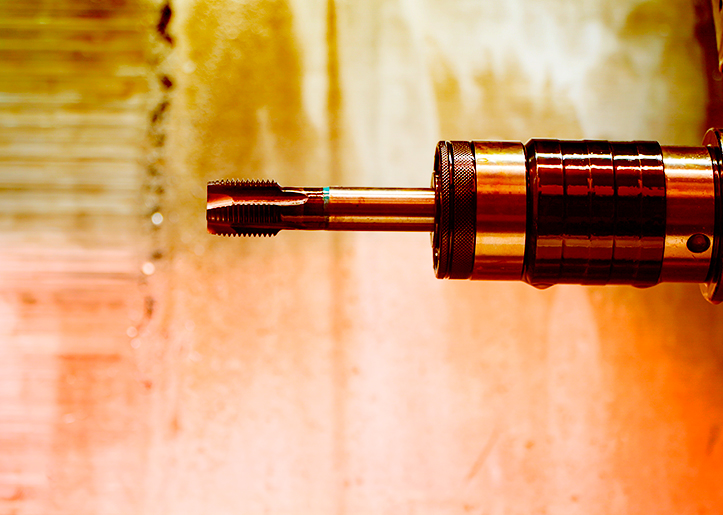Tempering is a heat treatment that is carried out on steel after hardening to achieve…

What is threading and how many types are there?
Discover what the threading process consists of, its importance in the machining of parts and the different types of threading that exist.
What is threading and how many types are there?
The process of threading consists of giving a helical shape to a cylindrical surface, whether external (screws) and internal (nuts) or taps and sockets. . It can be done manually or mechanically, depending on the type of thread and its function here are union threads for general use and union threads for pipes, such as NPT and BSP. The threading system is used in many industrial sectors that work with metallic material.
How does the threading process work?
Nowadays, threading is a process that can be done manually or by machine. For manual threading, taps and dies (cutting tools) are used, being a simple process mechanically but time-consuming as it is manual; while for machine threading, thread rolling, turning or milling are used.
What types of threading are there
Manual threading uses two cutting tools, depending on the type of thread to be made If it is a female (or internal) thread, a “tap” or “tapping thread” is used If a male (or external) thread is to be made, a tap is used. Both processes require a tool, which will turn the cutting tools to create the threads.
The most sophisticated threading is milling, as it is very precise and is operator-driven with software and is used for external or internal threads; this simplifies the process, making it faster and cheaper. thread turning uses lathes and is an interval process and is very productive, allowing the production of male and female threads (internal and external) of any type. Thread rolling is used for large production runs and is a method that does not use cutting but rather the displacement of the fibres, reducing the cost of production.
The threading process produces many types of threads (there are more than 20 types), depending on the different parameters established, such as the position, shape, number of threads or the direction of the helix. Thus we have the general or common use threads (ISO metric, UNF…) and those for pipes (BSP, NPT…).
ISO metric threads
ISO metric threads are based on the decimal metric system and are the most commonly used in the European industrial sector. Their shape is cylindrical, their thread forms an equilateral triangle, with truncated vertices and rounded valleys, and the flank angle is 60º. They are designated according to ISO 68-1 and ISO 965-1 and with a letter M according to the nominal diameter if they are coarse-pitch.
UNF thread
UNF threads are almost identical to ISO metric threads, except that they are based on the imperial system and are the most commonly used in industry in the United States. They are fine pitch and are named according to ANSI/ASME B1.1 with the nominal diameter in inches, the pitch in threads and finally the letters UNF They are more resistant to torsion and tensile strength.
NPT threads
NPT (National Pipe Thread) threads for pipes were developed in the United States in the mid-19th century by the mechanical engineer William Sellers. Their shape is conical (both male and female) and the angle of the thread threads is 60º. It is designated according to ANSI B1.20.1 with the abbreviation NPT, preceded by the diameter of the pipe and the number of threads per inch, both separated by a hyphen.
Its conical shape makes it suitable to use some kind of complement for its sealing, such as a sealing product or Teflon tape NPT threads became standard on public and railway works in the United States and are now the most widely used thread type in the United States and Canada.
BSP thread
The BSP thread (British Standard Pipe, also known as Gas thread) came into existence before the NPT thread and is derived from a thread created by the English mechanical engineer Sir Joseph Whitworth t was chosen as the standard pipe thread for the whole world, except in North America (USA and Canada), of course. Its shape is an isosceles triangle and the angle of the thread threads is 55º.
The smaller side of the triangle is equal to the pitch and its valleys and ridges are rounded, which means that it does not need any extra sealing material. Its designation is according to DIN ISO 228/1 and equivalent standards (ISO 7.1, UNE-EN ISO 228-1…), the diameter is expressed in inches and the pitch by the threads in each inch. The BSP thread is mainly used in low pressure plumbing.
There are two variants: the BSPP (cylindrical) and the BSPT (conical) In addition to the design, they differ in the degree of taper and the type of seal required: the former requires an O-ring or washer and the latter a coating on the thread.
Thread applications in industry
As mentioned above, both types of threads are widely used in public works, railways and all types of pipelines pipes and systems for liquids and fluids (gas, water, oil, etc.). They are mainly used in the construction and industrial sectors for fastening, joining and for moving machinery or motors. Threads are commonly used in screws, nuts and bolts.
EONSI, threading and machining experts
EONSI strengthens the different industrial sectors by specialising in threading and machining. Our R&D and R&D&I department always offers an innovative approach and we are leaders in technical training. Do not hesitate to contact us and discover our range of products and services in the Technical Classroom.



